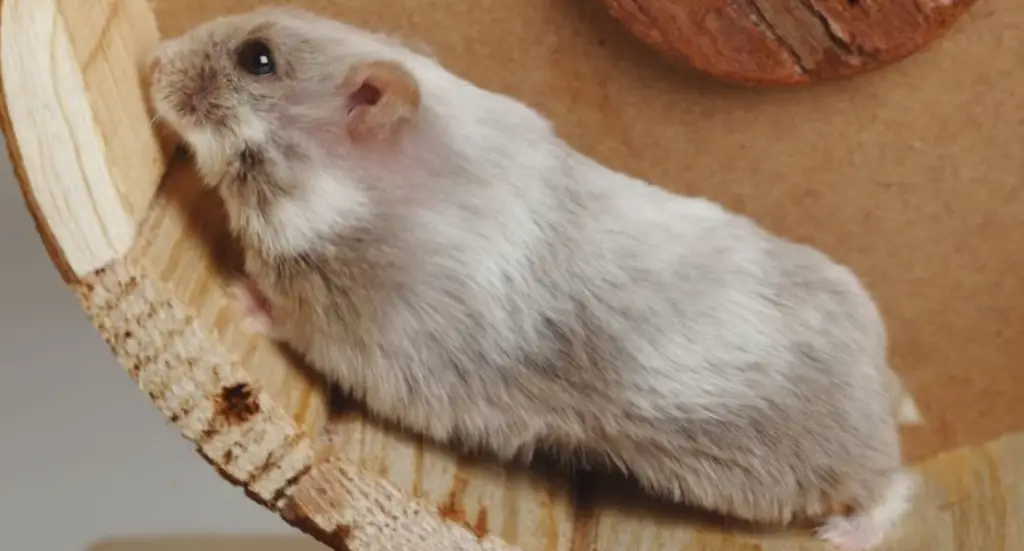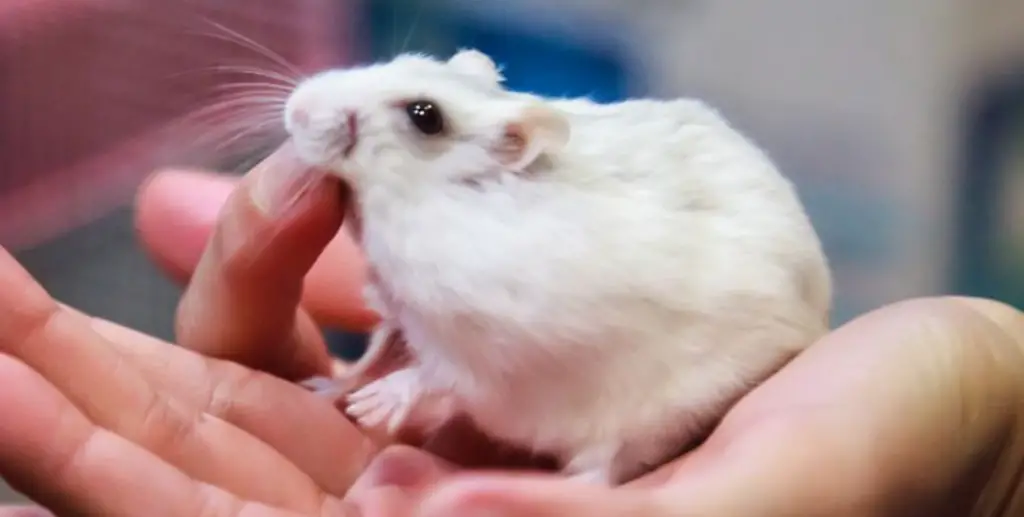How is a new hamster behaving?
When you buy a new hamster, it is not uncommon for it to eat and drink little or not at all for the first couple of days. It will also probably not show itself until it is sure that you are not around and will not touch its toys until after a few days. it may also stay awake all this time and explore its cage, climb the bars, dig its first burrows.
Why do new hamsters act this way?
When you take a closer look at the situation you will understand that the New hamster is probably stressed and suffering from meta-thesio-phobia due to several factors such as
The fact that your hamster has just been torn away from his family, his brothers and sisters and his litter mates.
Your hamster is alone for the first time in its life, which makes it the most stressful day of its existence.
The stress of the trip, the new smells, the new noises, don’t forget that he is a prey and he can’t run away!
He doesn’t know if he is safe, he doesn’t trust you yet because you can be a threat !
He doesn’t know if this new territory (his cage) which has strange smells, doesn’t belong to another hamster bigger than him who will attack him once he’s back from picking !
He will not risk his life and leave his nest to eat or drink especially if he hears noise, sees light and knows that you are not far away.
He probably won’t play with his wheel because he may not even know what it is and it will take him some time to learn how to use it.
So it’s normal if your hamster hides in a burrow, a tunnel or its nest for the first two or three days, or even the first week when you bring it home for the first time.
Should I be concerned if my new hamster does not eat during the first few days?
Don’t worry, because your hamster has probably brought back its cheeks full of food, especially seeds.
As far as water is concerned, you should know that hamsters, when they feel in great danger, can survive up to 4 days without eating or drinking, so don’t worry.
Also be sure that when your hamster feels really hungry or thirsty, he will wait until he is sure that you have gone to bed and he will quickly go out, drink water, fill his jowls with seeds and quickly return to his nest.
He will do this during the first few days, he will spend most of his time sleeping and will only come out of his nest when he doesn’t hear you, he will be very fearful and very careful.
He will quickly run to his water bowl and drink a few gulps and then to his dry food to fill his cheeks and go to empty them in his nest and make back and forth until he empties the bowl of seeds.
Thus, he will not be obliged to risk outside his burrow to eat.
How long will this avoidance behavior of the new hamsters last?
This situation can last from one to three weeks, depending on the origin of your hamster, its character, its age, is it already tamed or not, is it sick or not but above all is it going to facilitate the installation and adaptation or not!
How to help your new hamster to adapt quickly to its new environment (its new cage).
My first advice is to go and bring back some bedding from his old cage, take with you some natural tissue paper and soak it with the smells of his old cage and put it all in his new cage.
You must then give your hamster enough time to finally understand on his own that first of all:
He is not only safe in his nest, hideoiuts and burrows, but also in his cage.
1- You will actually help him to understand this by opening the cage door only once in the middle of the day, when your hamster is sleeping, give him his food and water ration and close the door quickly and quietly and move away from the cage.
2- During the first two or three weeks, only clean the cage if a litter box really stinks, change it very quickly or if your hamster spills its water…
And leave the first big cleaning for at least two months and don’t forget to put back at least a third of its old litter after the cleaning to keep the same smell, the one of your hamster to avoid stressing it too much again.
3- Make sure that you are the only person to interact with your hamster during the first few days.
Also avoid too many people or noise in the room where you have installed his cage.
You should also know that the ideal room temperature is 65-75 degrees Fahrenheit.
4- To help your hamster settle into its new home quickly, avoid turning on the lights in its room at night unless it is an emergency.
5-During the first two or three days, avoid entering his room when you hear him during the night or do not turn on the light if he sleeps with you , don’t forget they are nocturnal pets .
6-During the first week, if your hamster doesn’t run away from you when he sees you, avoid sudden movements, don’t get too close to his cage, sit on a chain and talk softly to your hamster and start the taming process.
7-Your hamster should only see your cat or dog once you have finished taming it, because if you introduce your cat in its room for the first few days and it sees it, you will lengthen the time of adaptation to its new environment by several weeks.
8- Wash your hands well before introducing them into your new hamster’s cage, especially if you are playing with your cat or dog or another hamster!
9-Provide at least two hideouts for your new hamster, so that it feels safe inside and chew toys and some willow sticks that will help your hamster relax chewing.
10- Ask your vendor for some of your hamster’s regular food, while you prepare a new mix and better food.
11- Also buy some meal worms, they will help your hamster to gain weight if he loses it because of a few days of stress.
How to know if my New hamster has finally adopted his new cage ?
If all goes well, after 10 to 15 days, your hamster will start to appropriate places and objects, even in broad daylight when it happens to wake up. it will claim its new home:
- He will deposit his smell on all the elements of the cage thanks to his glands or by licking his hairs and then rubbing himself against the objects like on the toys, the grids of his cage, the wheel, the hideouts, the sandbox ….
- He will choose a corner or two to pee and do his business
- He will dig burrows
- He will start to eat on the spot whereas before he was content to bring his food and eat it in his nest.
- He will drink more water than before
- He will start to be interested in you, what you do and come out to look at you every time you enter the room and make noise or open the door of his cage.
- He will behave like the owner of the place and will even be able to make small naps outside his nest, just in a corner of the cage, sign that he is in confidence and that he is not afraid of you anymore!
After how many days should I start to worry if my new hamster avoids me and continues to hide in its nest?
If after three weeks, your hamster’s behavior is still the same, you will have to check these few points:
1- Is it not your behavior or another factor that continues to scare him?
Read the list above and check if you are OK with all the points.
2- If not, you’ll need to check that he’s not showing any symptoms of possible health problems.
Your hamster may also be ill and this is what causes his stress and dictates his behavior.
How will you check the health of your new hamster?
You will not take your hamster out of its nest to inspect it but look for symptoms of probable illness just by observation.
You will manage to stay up late into the night and watch for your hamster to come out, if you can install the red light in his room that would be better.
You will check three things in your hamster:
1- During these outings, check that your hamster has not lost weight!
As you know, a healthy hamster is just a hairball with 4 legs, but if your hamster is losing weight, you will start to notice a slimmer face, a slimmer neck and even a slimmer body with a spine that is more distinct along the back.
2- Try to see if his nose, eyes and ears are dry.
3- This one is the easiest to check, it’s his droppings, the poop !
They should be dry, brownish black, like little black pellets.
It would be a bad sign if these droppings are round or soft or completely liquid, sign of diarrhea !
The wet tail is also when the tail area is wet.
So if you notice any of these symptoms in your hamster, capture him gently with a cup or directly with his travel crate and take him to his vet.
If not, know that it is probably due to your behavior or the surrounding smells or sounds that will require more time for your hamster to adapt to its new habitat and to you, your family and your other pets.
So just be a little more patient!
Other likely behaviors of new hamsters
Unlike the previous case, which is the most common, a new hamster may also be more confident and stay awake the longest during its first few days and spend all its time exploring its cage, playing with the wheel if it has already been weaned, and digging burrows to relieve its stress and carry its food into its nest…
Let’s summarize this
When you buy a new hamster, expect him to stress a bit, he will hide from you and maybe not eat or drink for two or three days.
He will also take his time, analyzing his surroundings, you, the smells, the noises, so that he is sure that all this does not represent any danger for him.
Some hamsters start to be interested in people only after less than a week, while others can take their time and remain fearful for two or three weeks more.
Please follow my instructions to help your hamster be happy in its new home and be patient.
Give your new hamster a month and a half or two to allow it to show its true personality, and then you will get to know it better, tame it and predict its behavior.





